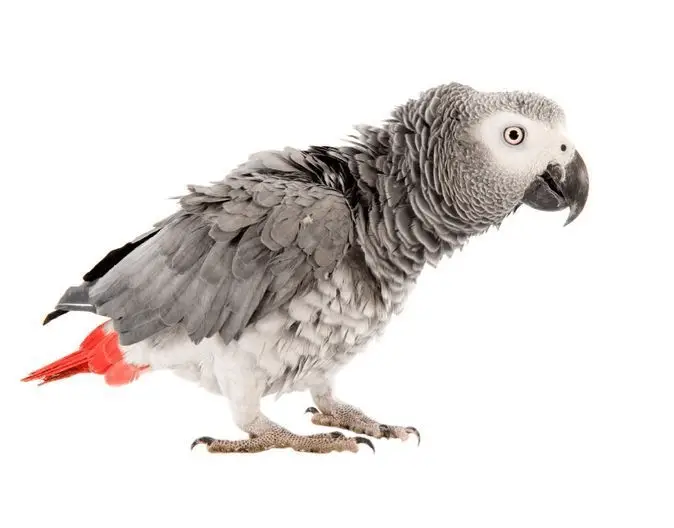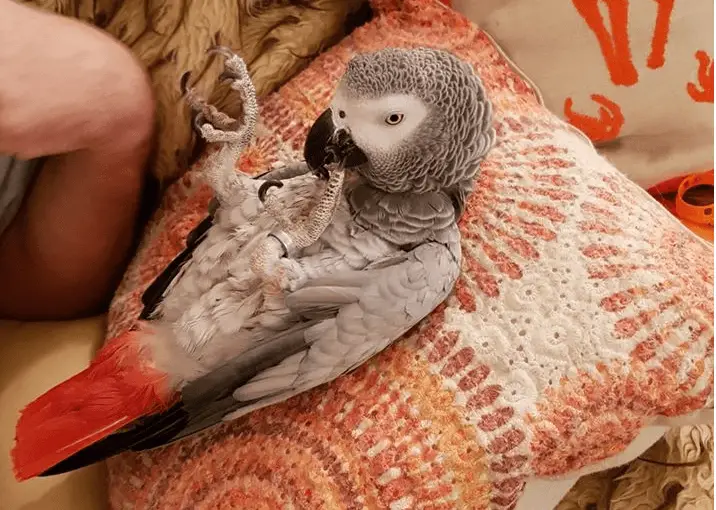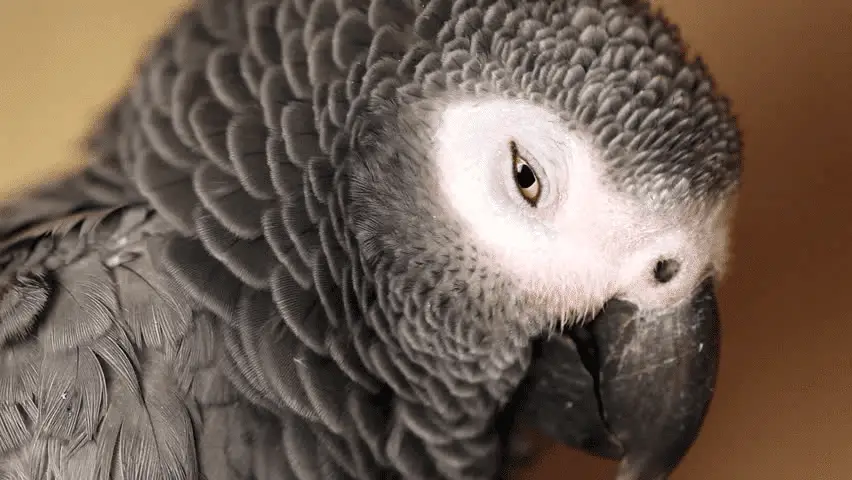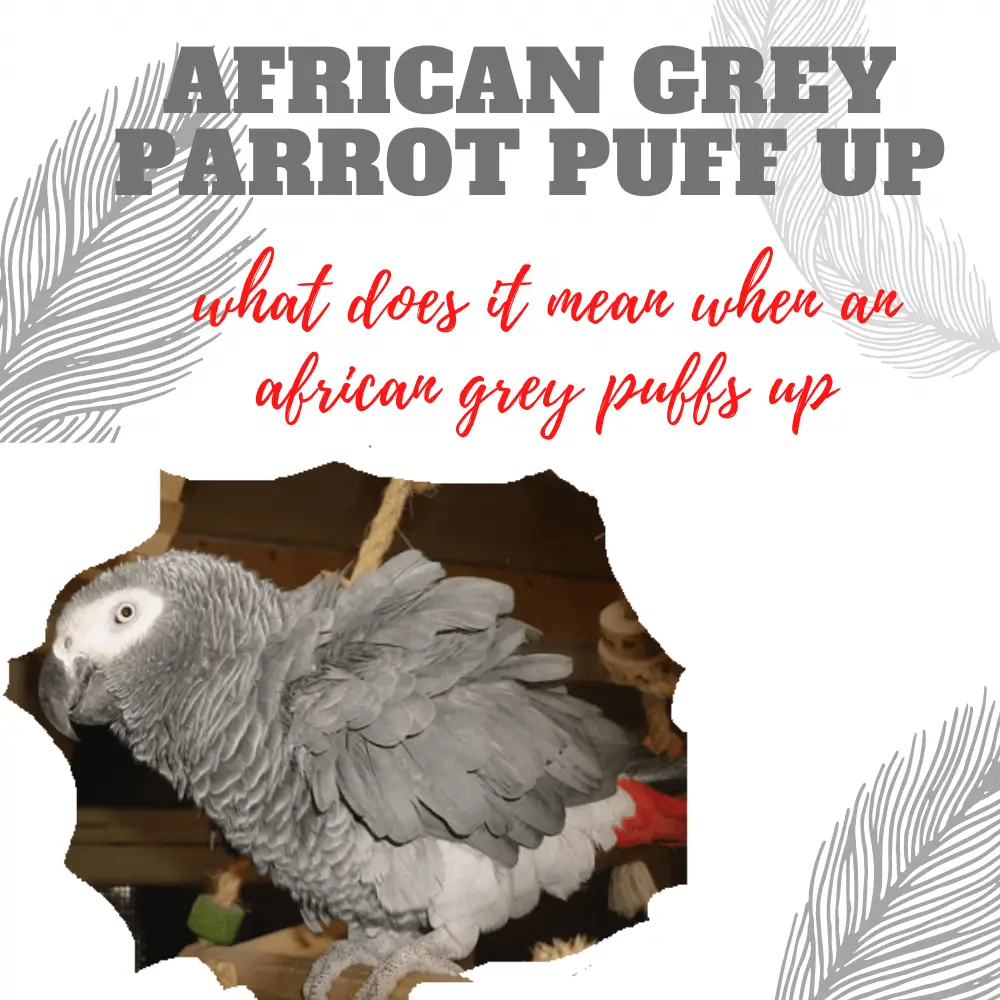African Grey Parrot puff up: parrot Ruffling feathers, The parrot can ruffle (parrot ruffle) or swell (parrot swell) their feathers during the smoothing process.
This helps remove any dirt or dust from the feathers and also helps return the feathers to their normal position. Birds can also be seen ruffling their feathers as a way to relieve tension.
If it’s cold, a bird can also inflate its feathers. Finally, if African Grey Parrot puffs up, it could be a sign of illness and it should be checked by your veterinarian.
what does it mean when an African grey puffs up
Birds such as cockatoos and cockatiels have a large expressive crest. A happy, relaxed bird will usually have the “relaxed” crest, with just the tip-tilted upward.
If he is excited by you, by a new toy, by a food product, etc. he will often lift the crest. If, however, the ridge is kept very high, it indicates fear or great excitement, and this should be taken as a warning. An aggressive or alarmed bird can hold its crest flat, stoop & or hiss.
The position of the crested parrot
African Grey Parrot Quivering feathers: Quivering can occur when the bird is frightened, overly excited, or doing some of the breeding behavior. [From my observations, they also do this when they want to warm up]
The body language of a parrot African grey African Grey Parrot puff up also includes how it places its feathers.
SOURCE: Charlie’s Chicks
African grey feathers

African Grey Parrot puff up
red tailed African grey parrot
 African grey growling: A African grey parrot growing feather tail, like the tail of other animals, is also used to communicate.
African grey growling: A African grey parrot growing feather tail, like the tail of other animals, is also used to communicate.
African Grey Parrot Wagging its tail
A bird, like a dog, can wag its tail to tell you that it is happy to see you. It can also be a warning signal for defecation. […]
Parrot African grey When turning the tail
A tail turn is a general sign of happiness and can be seen when the bird is happy to see you, plays with his favorite toy, or gets a treat.
A wagging tail parrot
If your bird is wagging its tail and has a rapid breath following intense exercise, it will recover its breath. However, if your bird is wagging its tail and breathing is difficult without activity, it may be showing signs of respiratory distress or infection. If this happens, consult your veterinarian.

A tail spread parrot: Spreading the feathers of the tail often accompanies other behaviors in a show of aggression or anger. The spread of the tail feathers is a spectacle that displays the strength and vitality of the bird.
African grey feet
Legs and feet are not used as often as other parts of the body to communicate, but they are some of the most interesting bird behaviors.
Tap foot: Some parrots like cockatoos will tap their legs as a sign of domination over their territory. This habit only occurs when they feel that their territory is threatened.
Some parrots do not want to stand up: this happens most often when you handle them and you have to put them back in their cage, for example, Collapsing is their way of resisting.
Just hold and pet the bird a little longer, and when it feels it has received enough attention, its legs will suddenly become strong enough to perch. Some birds become very good at this behavior and make it a routine.
Hanging upside down: Some birds consider that hanging upside down is a natural part of their behavior [conures for example!]. By doing this, they are happy and satisfied with their environment.
Scratching on the bottom of the cage: Birds of these species that normally feed on the ground for food, such as Grey Parrot, can scratch the bottom of the cage, like a chicken
Parrot African Grey Beak and head

African grey parrot beak care
The beak is used for several functions other than eating – from grooming to cracking nuts and seeds. It can be used to build a nest is in another situation as a weapon. There are also several ways for a bird to use its beak to tell you things.
Squeak: This squeak is often a sign of contentment in birds and is most often heard just before falling asleep. The bird creaks its beak by rubbing it from side to side. It is believed by some experts that birds squeak to keep it in its best condition.
Tap your beak: By tapping beak, or sliding one tip of the beak over the other, your bird can mean several things. If he taps once while fixing his eyes but is otherwise non-threatening, he greets you or recognizes something.
If he hits several times in a series, he gives a warning and should not be manipulated. Typing is most often seen in cockatiels and cockatoos.
African grey parrot wipe
It is common to see an African grey parrot wipe its beak after eating. Often, the bird will wipe its beak on a pole, the floor of the cage, or on the sides of the cage to make it clean.
Some parrots use wiping their beaks as a way to mark their territory. This behavior can be seen in birds when introduced to others or when they are kept in areas where other birds are close by.
African Grey Parrot Biting
Birds bite for several reasons, it is important to observe other behaviors and the immediate environment of the bird to determine the reason behind this behavior.
Defense of the territory, fear, or anger can cause a bite. An open bill combined with a squatting position and a hissing sound is a definite indication that the bird is ready to bite.
African Grey Parrot Chew
Most parrots enjoy chewing and do so for many reasons, including conditioning their beak and having fun. A variety of chew toys should be provided to keep your bird energized and interested and to keep him from chewing, and possibly ingesting, inappropriate things.
Regurgitation: regurgitation is the expulsion of the contents of the mouth, the esophagus, or the crop. If your bird fixes his eyes, flicks his head, and stretches his neck, then regurgitates his dinner, he shows you a lot of affection. Birds feed their young by regurgitating and breeding couples often do this for each other as a sign of affection.
Take in the beak: One way the birds play is to grab the beak and struggle. They often use their beaks to joust during the game. *
Shake the head: It is very common for African grays to nod. The reason for this is not well understood.
African grey Head Swing: Birds parrots that want attention can swing their head back and forth.
African Grey Parrot speech
SOURCE: Neo The Parrot
African grey parrot talking
In the wild, birds use various vocalizations to warn others of danger, attract partners, protect their territory, and to maintain social contact. Most birds are very vocal and can try to communicate with you many times.
Parrot African Grey Sing, speak and whistle
These vocalizations are often signs of a happy, healthy, happy parrot. Some birds like to have an audience and sing, speak and whistle more when others are around. Other parrots will remain silent when viewed.
African Grey Parrot Chat
Chat can be very soft or very loud. Soft chat can be a sign of contentment or can be a practice of speaking for some birds. Loud chatter can be a request for attention, reminding you that it is there. In the wild, birds often chat in the evening before going to sleep to connect with the other members of the group.
Parrot Purring
It is not the same purring as that of a cat, the purring of a parrot is more like a soft growl which can be a sign of contentment or a sign of boredom.
When a parrot purrs, the environment of the bird and other body language must be taken into account when determining what the bird is saying.
Tongue Clicking African grey parrot
By clicking its tongue against its beak, your bird can be entertained or ask to be petted or caught on you.
Growling: Although it is not a vocalization widespread in all the companion birds, the grunting is an aggressive vocalization.
If your parrot is sizzling, examine its environment and remove anything that may be disturbing it. Of course, if your bird growls, it shows that it does not want to be handled.
Parrot African Grey Wings
SOURCE: MARLENE MC’COHEN
Should You Clip Your Parrots Wings?
The wings are not always intended to fly; they are often used to communicate.
Flapping Wings: Flapping your wings, or flying in place, is used as an exercise, to grab your attention, or just to display happiness. Birds can often just raise their wings as a way to stretch or cool down.
African grey wing-flapping: When the bird spreads its wings, it can mean a lot of different things, like being angry or in pain.
It can also be used to inflate or replace feathers. Spreading of the wings accompanied by a curvature of the shoulder and a bobblehead means that the bird seeks to attract attention and often means that a bird wants to be fed.
It can also be a mating behavior. In this case, if you pay attention to it, you risk stimulating spawning and this should be avoided.
Drooping wings: Young birds must learn to fold and tuck their wings and often leave their wings low before learning this. However, in older birds, drooping wings may indicate disease. If the bird has just exercised or has recently bathed, it can do so by fatigue or to let the feathers dry.





















